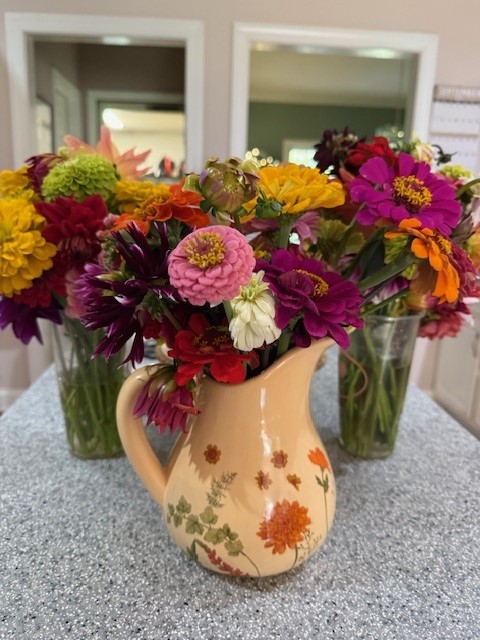
by Julie McConnell | Oct 30, 2025
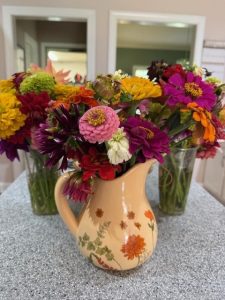 Do you enjoy cutting flowers from your garden to enjoy indoors?
Do you enjoy cutting flowers from your garden to enjoy indoors?
Have you ever considered turning that passion into a small business opportunity or earning a little cash to help to support your flower habit?
If you answered yes to these questions, then you should plan to attend the “Cut Flower 101 Growing for Fun & Profit” workshop on November 14, 2025, in Live Oak!
Flower farms are popping up across the state on small parcels of land, including urban settings. Social media posts of flower growers look like it’s all blooms and bucks, but there are a lot of factors that need to be weighed before jumping into any agricultural endeavor.
Learning what, when, and how to grow specific flowers are key factors to developing a successful grow plan. Options to consider include bed preparation for raised beds, crates, or in-ground production. Should you direct seed or grow transplants? When do you start the seeds and when do you put the seedlings outside? How to prepare for adverse weather conditions? Which types of irrigation and fertilization methods should you use? And of course, how much money is needed to invest for the best returns while minimizing risk?
All those choices may seem overwhelming, but you don’t have to figure it out on your own! Spend a day at the UF/IFAS Small Farms Academy at the North Florida Research and Education Center Suwanee Valley in Live Oak, Florida for an introduction to small scale cut-flower production.
Sidenote – Even if you have no inclination of starting a business, but just want to grow cut flowers you can enjoy you are welcome to attend!
Pre-registration is required by purchasing a ticket at https://www.eventbrite.com/e/cut-flower-101-tickets-1738264990379
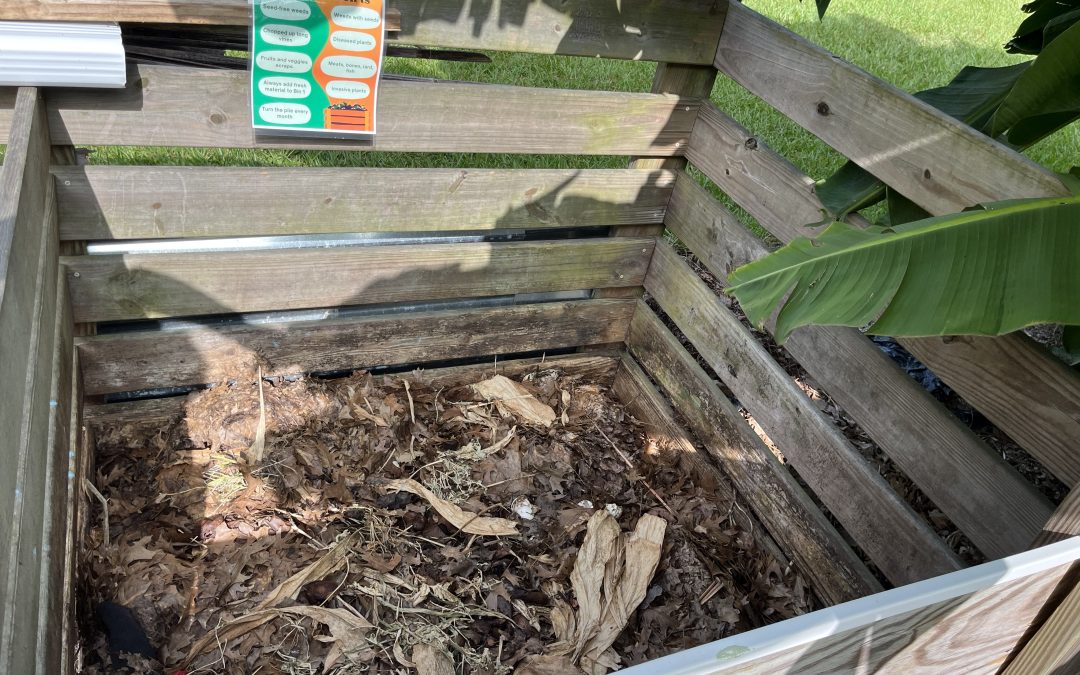
by Molly Jameson | Oct 30, 2025
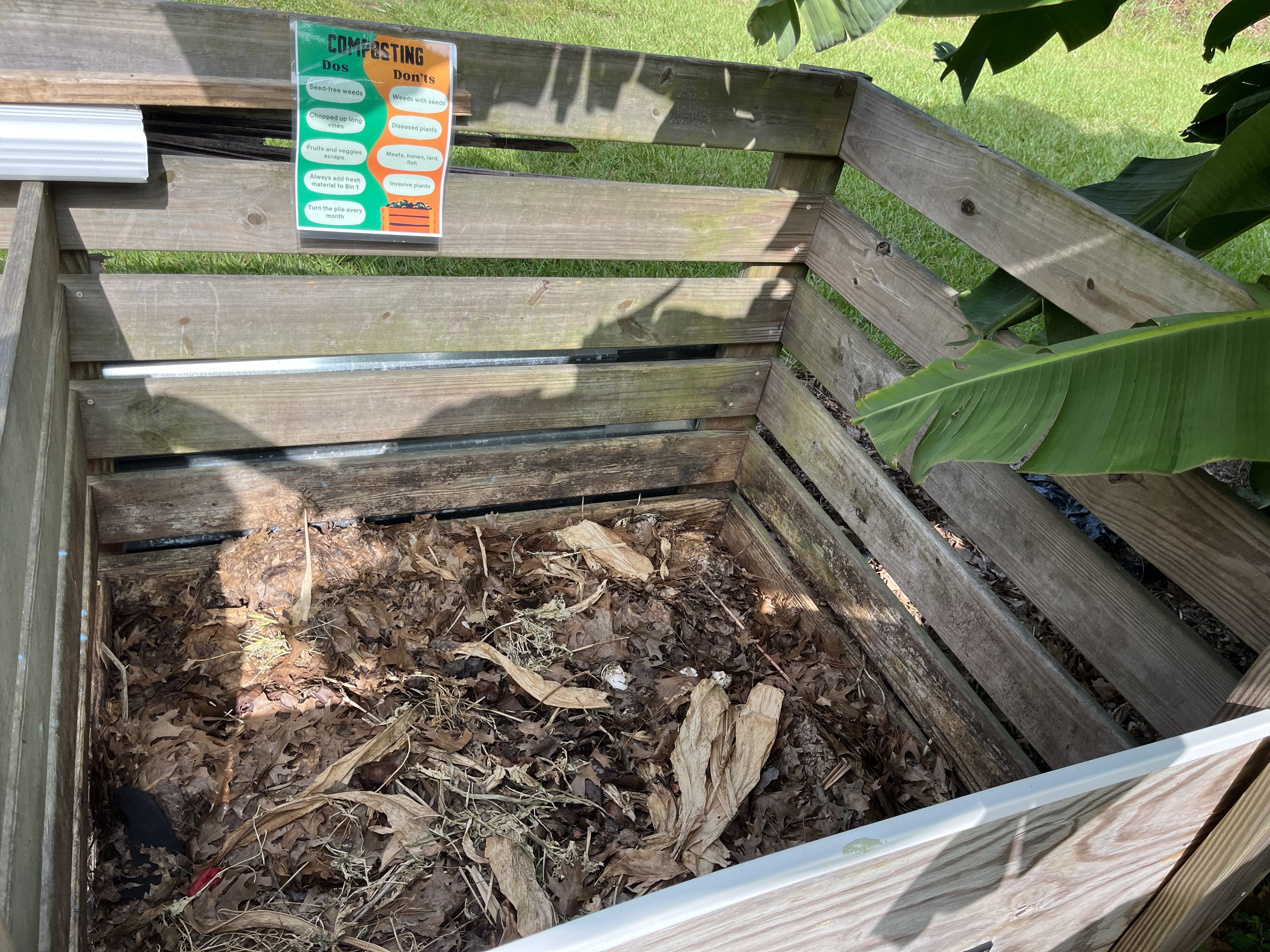
A simple wooden bin provides airflow and space for layering “browns” and “greens” to create balanced compost at home. Photo by Molly Jameson.
The Dirt on Compost: Hot and Worm Composting at Home
Every week, many of us dump spoiled food or leftovers into the trash and haul yard waste to the curb, not realizing that all of that organic material could be turned into something incredibly useful. Composting is the answer. It’s a simple, natural process that transforms food scraps and yard debris into a rich soil amendment that feeds your plants and improves soil health.
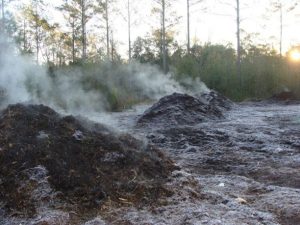
Microbial activity generates heat as organic matter breaks down, causing visible steam to rise from active thermophilic compost piles on cool mornings. Photo by Turkey Hill Farm.
There are two main ways to compost at home: thermophilic (hot) composting and vermicomposting (composting with worms).
Thermophilic composting is the classic backyard method that relies on heat-loving microbes to break down organic material. With the right mix of “browns” (carbon-rich materials like dried leaves, cardboard, and straw) and “greens” (nitrogen-rich materials like vegetable scraps, coffee grounds, and grass clippings), the pile heats up to between 130–160°F. This high heat speeds up decomposition and kills weed seeds and harmful pathogens. Turn the pile occasionally and keep it moist, and in a few months, you’ll have dark, earthy compost ready to mix into your garden beds.
Hot Composting Fun Facts
- Food scraps and yard waste make up nearly 30% of what we throw away, most of which could be composted instead.
- Microbes in a hot compost pile can double their population every 20–30 minutes under the right conditions.
- A compost pile needs at least one cubic yard (3x3x3 feet) of material to build enough mass to heat up properly.
- Steam rising from a compost pile on a chilly morning isn’t smoke – it’s water vapor from microbial activity.
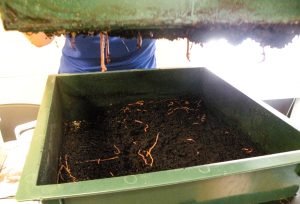
Red wiggler earthworms transform food scraps into nutrient-rich worm castings. Photo by Leon County.
Vermicomposting is a little different – and a bit squirmier. This method uses red wiggler earthworms (Eisenia fetida) to process kitchen scraps into a fine, nutrient-rich material called worm castings. Earthworm bins can be kept indoors or outside in a shaded area, making them a great option for those with limited space. It’s clean, odor-free when managed properly, and a surprisingly fun way to recycle your food waste.
Worm Composting Fun Facts
- Red wigglers can eat up to half their body weight in food scraps each day.
- Worms breathe through their skin and need moist bedding to survive and stay active.
- Worm castings contain five times more nitrogen and seven times more phosphorus than average topsoil.
- Worm castings contain beneficial microbes that help suppress certain plant diseases in soil.
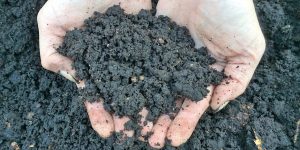
Finished vermicompost is dark, crumbly, and nutrient-rich – the result of red wigglers breaking down organic waste. Photo by John Edwards.
Both methods keep organic material out of the landfill, reduce methane emissions, and build healthier soil – something every gardener can appreciate.
If you’d like to learn even more about composting and hear additional fun facts about how nature recycles, join UF/IFAS Extension Agents Mark Tancig and Molly Jameson for The Dirt on Compost: Hot & Worm Composting at Home on Wednesday, November 12, from 6:00 to 8:00 p.m. at the Leon County Extension Office (615 East Paul Russell Road).
Register on Eventbrite: https://UFIFASLeonCompostingFall2025.eventbrite.com
This free workshop will explore the science behind composting and provide practical tips for both hot composting and worm composting systems.
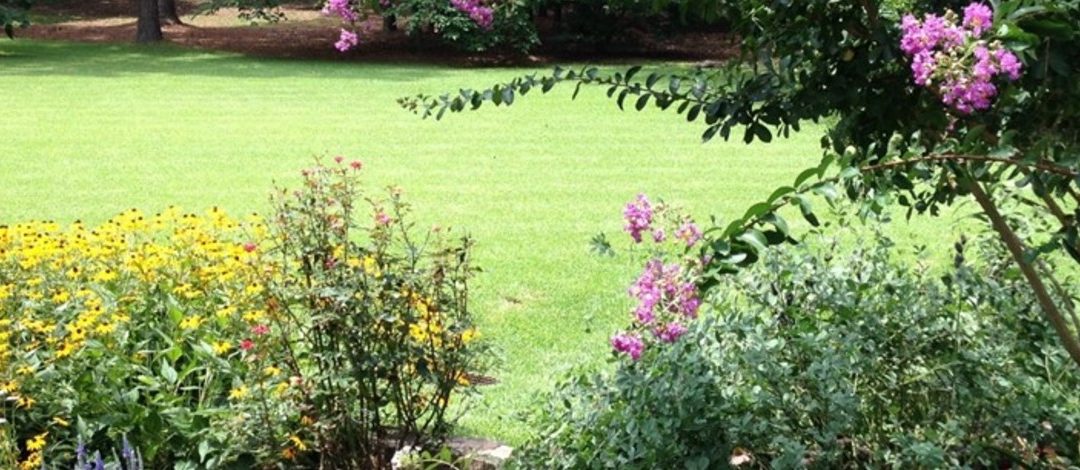
by Larry Williams | Oct 30, 2025
Over time, landscapes change and our needs change. Lawns, shrubs and trees are living and respond to their environment, growing and declining with time. Many older landscapes eventually need renovation and improvements. Older plants outgrow their space. Others decline. Large, open lawns for play may not be needed any longer as children become older and eventually move away.
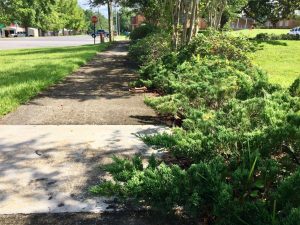
Consider removing spreading junipers growing over sidewalk with too much shade. Credit: Larry Williams
There are plants that are best removed from the landscape. They may become overgrown or become less than aesthetically pleasing. That’s a nice way to say they are ugly. The area may look better after removing old, declining, overgrown plants. Consider removing plants that require too much maintenance or that are pest prone.
Late summer through fall is a good time to do a walk-through of your landscape. Make notes if necessary as you visually inspect the plants. You get to see the plants that did great, the plants that didn’t do so great. You can make decisions on which plants to do away with, which to keep and which plants were more trouble than they were worth from a maintenance standpoint.
As you inspect your landscape, ask yourself questions. You can easily identify problem areas in the lawn. As you identify problem areas in the lawn, attempt to determine why those areas aren’t doing so well. Begin formulating plans for correcting those areas. Decide if renovating and replanting with grass is your best option. Or something other than grass may be the best option, particularly if there is a history of problems with grass in a specific location.
As a rule, when there is less than sixty percent coverage of the desirable lawn grass left, reestablishment should be considered. With time, the original lawn grass simply may have died out, leaving a mix of weeds, some of the original lawn grass, a volunteer grass in the mix and some bare ground. In the process of starting over, decide where lawn grass is needed or where it serves a purpose and consider other options in areas where grass may not be needed or where grass does not historically grow well.
It may be time to replace an older, declining plant with something new. There may be a plant that hasn’t performed up to par but that would do better if moved to a more appropriate location. Fall through early winter is a good time to relocate plants. Now is a good time to take a soil sample and possibly take the guesswork out of liming or fertilizing. The UF/IFAS Extension Office in your County can provide information on how to collect and submit a soil sample.

by Lauren Goldsby | Oct 23, 2025
One of my favorite ways to spend the morning lately is in the garden drinking my coffee. There’s no intended purpose, other than to look and see what I can find. I always end up finding something interesting! Scouting your garden does not have to be a formal process, but it is more effective when done regularly. This can help to avoid the “it happened overnight!” phenomenon that we hear frequently. Pests and diseases do not typically cause damage that quickly. Regular scouting helps you notice small symptoms before they become big problems. Training your brain to notice these small changes happens over time with your scouting, but just like any new skill, you need to practice! Give it a chance and watch the tiny world open up around you. Come scout the garden and see what we find.
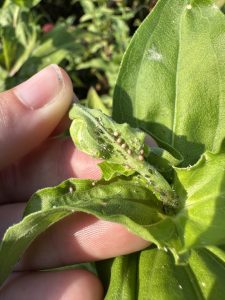
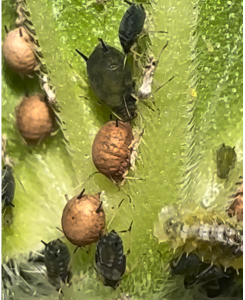
In this photo you can see a close up of the mummified vs. regular aphids. For more information on parasitic wasps and other natural enemies see: https://edis.ifas.ufl.edu/publication/IN120
I noticed some wrinkled leaves on the new growth of a zinnia. Wrinkled new growth can be a sign that a piercing-sucking insect is causing damage. Turning over the leaves revealed aphids, a common culprit on zinnia. In this photo we can see aphids in a few different life stages. Importantly, we also see that some of the aphids are serving as food for beneficial insects. These mummified aphids are the ones you see with tan, golden bodies that are larger and more round. A small, parasitic wasp larvae, is living inside the aphids body– using it for protection and food until it is ready to emerge. These are good signs of a healthy working ecosystem and they can help keep aphid populations in control. This helps me to know that there are aphids in my zinnias, but that I don’t need to do anything about them right now. Natural predators are at work and can be more effective than chemical applications at this time. If you need help identifying insects in your garden, reach out to your local extension office. Not all insects on our plants are causing harm; and some are actually helping decrease pests.
I don’t always find pests in the garden. Sometimes I realize the irrigation timer was turned off or I take a really pretty picture for my instagram story (see below). These are still wins in my book! Remember that your landscape is an entire ecosystem and you are a part of it. It’s a great practice to walk around and take an intentional look at your plants when you get the chance, you may see something cool!
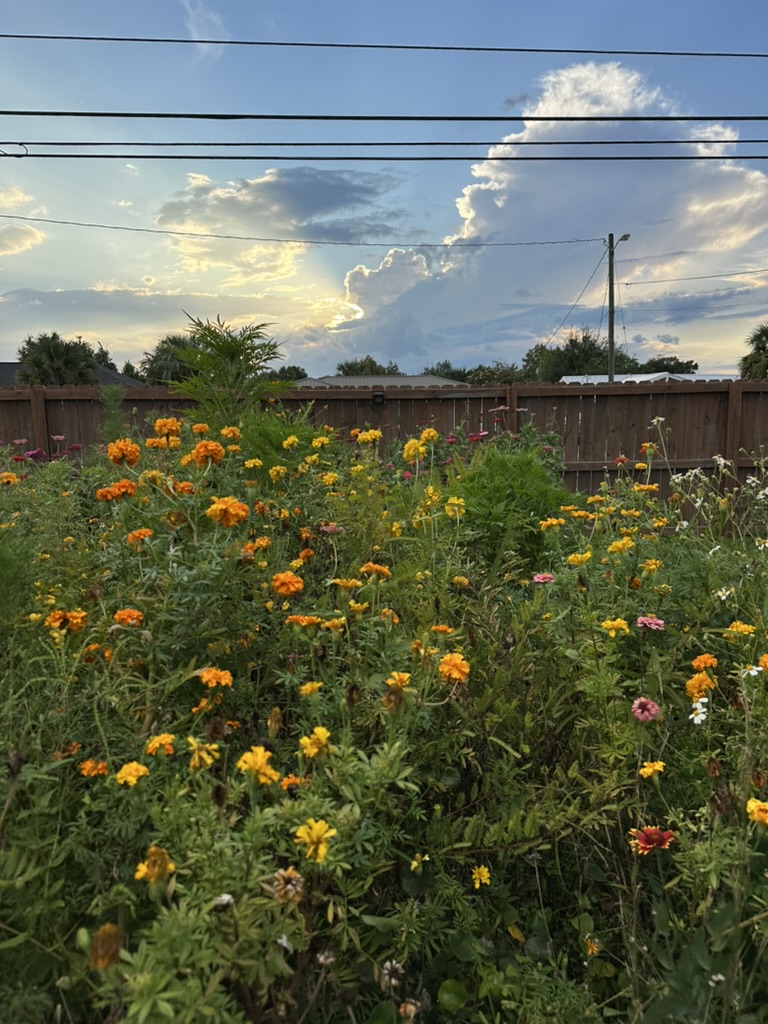

by Beth Bolles | Oct 23, 2025
One of our well known spiders found in landscapes is the Yellow and black garden spider, Argiope aurantia. Most people will recognize this beautiful spider that rests in a large web with a zigzag web pattern in the middle called a stablementum. A wide variety of insects will be caught in the web throughout the summer, with many prey larger than the spider itself. The Yellow and black orb weaver is just one of our beneficial spiders in landscapes.
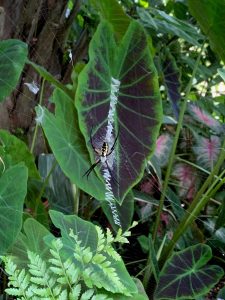
Garden spider waiting for a meal. Photo by Beth Bolles, UF IFAS Extension Escambia County.
As fall approaches each female garden spider leaves us a wonderful gift in the garden. She will create a very distintive egg sac that can be hidden in plants or hang in the corner of a porch. The sac is brown and pear shaped, supported by strands of web attached to branches or structures. Hundreds of eggs are inside and although they hatch in late fall, the spiderlings will stay in the sac until the spring. A large number of spiderlings will not survive due to predation and other factors, but a few will continue development to adorn your garden in the following season.
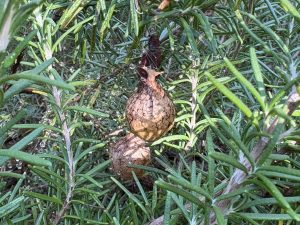
Egg sacs of the Yellow and black garden spider in a rosemary. Photo by Beth Bolles, UF IFAS Extension Escambia County.
If you did have a garden spider in your landscape this summer, just be a little more careful when maintaining plants. You don’t want to accidently remove the overwintering egg sac. Although this large spider can be startling for many people, they are not aggressive and are considered beneficial in the garden.

 Do you enjoy cutting flowers from your garden to enjoy indoors?
Do you enjoy cutting flowers from your garden to enjoy indoors?













